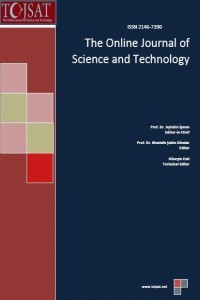Myco and Phyto Remediation of Heavy Metals from Aqueous Solution
Myco and Phyto Remediation of Heavy Metals from Aqueous Solution
Biosorption, Metals Fungi, Agricultural waste, Tree leaves,
___
- Ahalya, N., Kanamadi, R. D., & Ramachandra, T. V. (2005). Biosorption of chromium(VI) from aqueous solutions by the husk of bengal gram (Cicer arientinum). Electronic Journal of Biotechnology, 8, 258-264.
- Ali. E. H., & Hashem, M. (2007). Removal Efficiency of the Heavy Metals Zn(II), Pb(II) and Cd(II) by Saprolegnia delica and Trichoderma viride at Different pH Values and Temperature Degrees. Mycobiology, 35, 135-144 (
- Aslam, M. Z., Ramzan, N., Naveed, S., & Ferooz, N. (2010). Ni(II) removal by biosorption using Ficus religiosa (peepal) leaves. Journal of the Chilean Chemical Society, 55, 81-84.
- Bayramoglu, G., Bektas, S., & Arica, M. Y. (2003). Biosorption of heavy metals on immobilized white-rot fungus Trametes versicolor. Journal of Hazardous Material, 101, 285-300.
- Das N., Vimala, R., & Karthika, P. (2008). Biosorption of heavy metals-An Overview. Indian Journal of Biotechnology, 17, 159169.
- Dubey, S. P., & Krishna, G. (2007). Adsorption of chromium (VI) on low cost adsorbents derived from agricultural wastematerial. Journal of Hazardous Materials, 145, 465-470.
- El-Syed, G.O., Dessouki, H.A., & Ibrahim, S.S. (2010). Biosorption Of Ni (II) And Cd (II) Ions From Aqueous Solutions Onto Rice Straw. Chemical Sciences Journal, 2010, CSJ-9.
- Fourest, E., & Roux, J. C. (1992). Heavy metal biosorption by fungal mycelial by-products: mechanisms and influence of pH. Applied Microbiology Biotechnology, 3, 399–403.
- Gadd, G. M. (1993). Interaction of fungi with toxic metals. New Phytology, 124, 25-60.
- Hmambika, B., Rani, M. J., & Kannan, V. R. (2011). Biosorption of heavy metals by immobilized and dead fungal cells: A comparative assessment. Journal of Ecology and the Natural Environment, 3, 168-175.
- Jain, M., Garg, V. K., & Kadirvelu, K. (2009). Chromium VI) removal from aqueous system using Helianthus annuus (sunflower) stem waste. Journal of Hazardous material, 162, 365-372.
- Javaid, A., Bajwa, R., & Javaid, A. (2010). Biosorption of heavy metals using a Dead Macro Fungus: Evaluation of Equilibrium and Kinetic Models. Pakistan Journal of Botany, 42, 2105-2118.
- Lokeshwari, N., & Joshi, K. (2009). Biosorption of heavy metal (Chromium) by using biomass. Global Journal of Environmental Research, 3, 29-35.
- Malkoc, E., Nuhoglu, Y., & Dundar, M. (2006). Adsorption of chromium (VI) on pomace-An olive industry waste: Batch and column studies. Journal of Hazardous Materials, 138, 142-151.
- Mazali, I. O., & Alves, O. L. (2005) Morphosynthesis: high fidelity inorganic replica of the fibrous network of loofa sponge (Luffa cylindrica). Anais Da Academia Brasileira De Ciências, 77, 25-31.
- Oboh, I., Aluyor, E., & Audu, T. (2009). Biosorption of Heavy Metal Ions from Aqueous Solutions Using a Biomaterial. Leonardo Journal of Sciences, 14, 58-65.
- Pal, T. K., Bhattacharyya, S., & Basumajumdar, A. (2010). Cellular distribution of bioaccumulated toxic heavy metals in Aspergillus niger and Rhizopus arrhizus. International Journal Pharmaceutical and Biological Sciences, 1, 1-6.
- Qaiser, S., Saleemi, A. R., & Ahmad, M. M. (2007). Heavy metals uptake by agro based waste material. Electronic Journal of Biotechnology, 10, 410-416.
- Rajender, K., Narsi, B., Garma, & Kiran, B. (2008). Biosorption of chromium(VI) from aqueous solution and electroplating wastewater using fungal biomass, Chemical Engineering Journal, 135, 202-208.
- Rowell, R. M., Pettersen, R., Han, J. S., Rowell, J. S., & Tshabalala, M. A. (2005), Cell wall chemistry. In: Handbook of wood chemistry and wood composites. Ed. Rowell, R.M., CRC Press, Boca Raton, FL., pp. 35-72.
- Siegel, S. M., Gallun, M., Keller, P., & Siegel, B. Z. (1990). Filamentous fungi as metal biosorbents: A review. Water, Air and Soil Pollution, 53, 335-344.
- Sun, Y-M., Horng, C-Y., Chnag, F-L., & Tiang, W-X. (2010). Biosorption of lead, Mercury and Cadmium by Aspergillus terreus immobilized in natural matrix. Polish Journal of Microbiology, 59, 37-44.
- Tsezos, M., & Volesky, B. (1981). Biosorption of uranium and thorium. Biotechnology and Bioengineering, 23, 583-604.
- Volesky, B. (2003). Sorption and Biosorption (ISBN #0-9732983-0-8). BV Sorbex, Montreal-St.Lambert, Canada, 316.
- Weast, R. C. (1988). CRC Handbook of Chemistry and Physics. CRC Press, Inc., Boca Raton, Fla.
- Zvinowanda, C. M., Okonkwo, J. O., Agyei, N. M., Staden, M. V., Jordaan, W., & Kharebe, B. V. (2010). Recovery of Lead(II) from Aqueous Solutions by Zea mays Tassel Biosorption American Journal of Biochemistry and Biotechnology 6, 1-10.
- ISSN: 2146-7390
- Başlangıç: 2011
- Yayıncı: The association of science, education and technology
Myco and Phyto Remediation of Heavy Metals from Aqueous Solution
Amna Shoaib, Nabila Aslam, Nida Aslam
The effect of monks in the Hungarian Urban Design and Landscape Forming
The Shell Characteristics of Land Snail Eobania Vermiculata (Müller, 1774) From Croatia
Biljana Rađa, Tonći Rađa, Mate ŠAntić
The Effect of Hypergravity on the Germination and Growth of Eruca Sativa Mill
MARLISE ARAUJO DOS SANTOS, THAIS RUSSOMANO, FLAVIA NATHIELY SILVEIRA FACHEL, EDUARDO CASSEL, LEANDRO VIEIRA ASTARITA
Semantic Adaptation Approach for Adaptive Web-Based Systems
Bujar Raufi, Artan Luma, Xhemal Zenuni, Florije Ismaili
Virtualmatriks: A Conceptual Mathematization Process in Virtual Learning Environment
Laboratory Stands for Wideband Analysis Radiocommunication Signals
Ryszard Studanski, Radosław Was, Agnieszka Studanska, Jarosław Garus
Probiotic Potential of Lactic Acid Bacteria Isolated from Human Gut
Benkherbache N. Benniou R., Merat M., Mekhalfia T., Makhlouf M.
Numerical Properties of Stochastic Linear Quadratic Model with Applications in Finance
